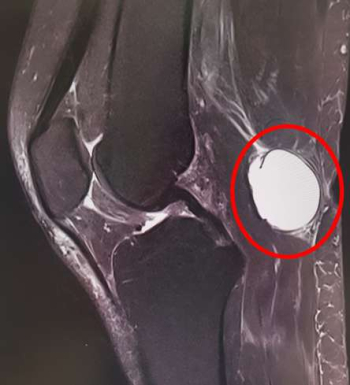Baker's cyst
Table of contents
What is a Baker's cyst?
A Baker's cyst is a fluid-filled cyst in the hollow of the knee. A Baker's cyst usually develops as a result of chronic knee joint damage, such as meniscus or cartilage damage. The stimulus of the chronic damage causes the body to produce more joint fluid (synovial fluid). This increases the pressure inside the joint capsule and causes it to bulge out towards the back of the knee, as this is where the joint capsule is weak. This protrusion filled with synovial fluid is called a Baker's cyst.

Symptoms of a Baker's cyst
The symptoms of a Baker's cyst depend on the size of the cyst and the load on the knee joint. Large cysts are usually easily palpable in the back of the knee. Baker's cysts can cause a pressure-sensitive swelling, a feeling of tension and pain in the back of the knee. If the knee joint is subjected to increased stress, the production of synovial fluid usually causes the Baker's cyst to enlarge and the symptoms to increase. After rest, the symptoms usually decrease or disappear completely. Pressure from the Baker's cyst on nearby nerves or vessels can cause numbness or circulatory problems in the affected leg. Very large Baker's cysts can lead to restricted movement in the knee joint. If a Baker's cyst bursts, there may be sudden severe pain in the knee joint and subsequently inflammatory reactions in the knee and lower leg.
Diagnosis of a Baker's cyst
Diagnosis initially involves a detailed discussion with the patient about the course of the disease and any previous illnesses, as well as a thorough clinical examination. With the help of a magnetic resonance examination (MRI), the exact size and extent of the Baker's cyst can be determined. Furthermore, meniscus and cartilage damage, which can be the cause of the Baker's cyst, can be determined.
Therapy of a Baker's cyst
Small Baker's cysts, which do not cause any symptoms and are often discovered as an incidental finding, do not require therapy. Symptomatic Baker's cysts can first be treated conservatively (non-surgically) with painkilling and anti-inflammatory medication. If conservative therapy is unsuccessful, the Baker's cyst can be surgically removed. However, the most important thing is to treat the underlying cause of the Baker's cyst, such as meniscus and cartilage damage. These should be repaired during an arthroscopy of the knee joint. If the cause is not treated, the Baker's cyst will usually recur in a short time.